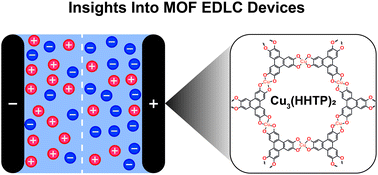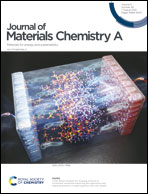Insights into the electric double-layer capacitance of two-dimensional electrically conductive metal–organic frameworks†
Abstract
Two-dimensional electrically conductive metal–organic frameworks (MOFs) have emerged as promising model electrodes for use in electric double-layer capacitors (EDLCs). However, a number of fundamental questions about the behaviour of this class of materials in EDLCs remain unanswered, including the effect of the identity of the metal node and organic linker molecule on capacitive performance, and the limitations of current conductive MOFs in these devices relative to traditional activated carbon electrode materials. Herein, we address both these questions via a detailed study of the capacitive performance of the framework Cu3(HHTP)2 (HHTP = 2,3,6,7,10,11-hexahydroxytriphenylene) with an acetonitrile-based electrolyte, finding a specific capacitance of 110–114 F g−1 at current densities of 0.04–0.05 A g−1 and a modest rate capability. By directly comparing its performance with the previously reported analogue, Ni3(HITP)2 (HITP = 2,3,6,7,10,11-hexaiminotriphenylene), we illustrate that capacitive performance is largely independent of the identity of the metal node and organic linker molecule in these nearly isostructural MOFs. Importantly, this result suggests that EDLC performance in general is uniquely defined by the 3D structure of the electrodes and the electrolyte, a significant finding not demonstrated using traditional electrode materials. Finally, we probe the limitations of Cu3(HHTP)2 in EDLCs, finding a limited stable double-layer voltage window of 1 V and only a modest capacitance retention of 81% over 30 000 cycles, both significantly lower than state-of-the-art porous carbons. These important insights will aid the design of future conductive MOFs with greater EDLC performances.



 Please wait while we load your content...
Please wait while we load your content...